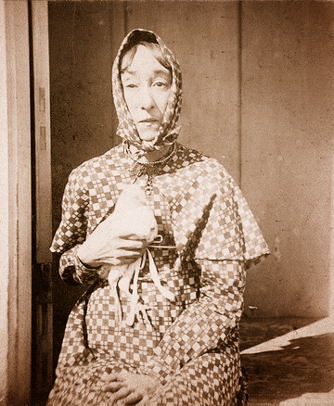A New Work: The Nancy Luce Story
Nancy Luce (1814-1890)
This story has so many moving parts that I feel it’s impossible to relate its exact point of origin. It may be best to start at the beginning of my own exposure to one Nancy Luce of West Tisbury, Massachusetts.
Several years ago, my step-mother Susan came across a piece of paper in a Philadelphia thrift store that depicted a woman flying through the air with several chickens in tow. Not knowing where it came from or how it got there, she bought it for a dollar, and it has been hanging in her and my father’s West Philly home ever since. Following the completion of my PhD in the fall of 2017, I agreed to take care of their animals in exchange for a place to live and work in the city while they were abroad in Europe. Little did I know that the constant presence of Nancy Luce on the wall next to the piano where I worked would end up being the inspiration for a remarkable project that I believe, if all goes well, could be an unusual and interesting contribution to the field of choral music.
It seems remarkable now that none of us stopped to ask who Nancy Luce was, why she was accompanied by chickens, or why the artist (who I later learned was the talented Dan Waters of Martha’s Vineyard) was so taken by her that he spent hours creating this piece of art. However, one day in early December of 2017 I asked that question, and by asking that question the three of us stumbled onto a remarkable and relatively forgotten historical figure. Often referred to quite callously as “the chicken lady of Martha’s Vineyard,” Nancy Luce (1814 – 1890) lived alone on her homestead in West Tisbury, Massachusetts. She suffered chronic pain, endured life as an object of scorn, and lived mainly for her beloved chickens. She left behind a volume of sacred and secular poetry and, interestingly, a collection of newspaper columns detailing how to care for chickens and their ailments.
The creative process, for me at least, is rarely linear and often jumps backward to prior experiences in search of inspiration. Upon reading the story and poetry of Ms. Luce, I was transported back to my time at Westminster Choir College, when I first performed one of Benjamin Britten’s great works, Rejoice in the Lamb, with James Jordan and Westminster Williamson Voices. In some strange, small and intimate way, the poetry of Christopher Smart, whose poem Jubilate Agno serves at the basis for Britten’s work, seemed to coalesce with the words of Ms. Luce. Both had a profound belief and faith in God, and both had a seemingly loving, if not slightly obsessive, interest in animals as the servants of God. In addition to this, each poet felt oppressed by the people who surrounded them; Smart by the attendants who dealt with him in the asylum, and Luce by the locals who seemingly abused and ridiculed her.
After some time stewing on this relationship, I came upon the idea to compose a new choral work to act as a companion piece to Rejoice in the Lamb; a work based on the life and writings of Nancy Luce, one that will do justice both to her own experiences and those of Christopher Smart and Benjamin Britten. I feel that Nancy Luce’s story, no matter how specific to the area surrounding Martha’s Vineyard, deserves to be experienced by audiences the world over.
I cannot tell you the number of people who have told me I am crazy for pursuing this forgotten corner of American history as an inspiration for a new choral work. Many have told me “I just don’t get it,” or, even worse, and more cutting, “Tom, I think you’re making a big mistake here.” But I’ve done this for long enough to know when a good story deserves a wider audience. When I travelled to Calumet in the copper country of Michigan in search of more information about the Italian Hall disaster, many people greeted me with skepticism, even outright hostility at the thought of memorializing the victims of that tragedy in a new musical composition. A Child’s Requiem, a major work based on the events of that horrible Christmas eve of 2013, produced in collaboration with the poet Esther Margaret Ayers and the Marquette Symphony Orchestra, now remains one of the most memorable experiences of both the community at large and my own professional career.
It is for this reason that invite you all, members of the choral community at large, to take part in this new project. Tomorrow I leave for Martha’s Vineyard to discover what I can about Nancy Luce, to visit her grave and learn a bit more of what her life was like. Her devotion to her beloved animal charges, her clear desire for greater kindness in the world; these are aspects of her existence that speak more loudly to the problems facing our world than many voices that exist today. Thanks are due especially to James Jordan and the board of The Same Stream choir of Philadelphia, who have believed in this project from the beginning and have agreed to pursue the outcome in honor of Nancy Luce, Benjamin Britten and Christopher Smart.
If you would like to know more or learn how to participate, please visit this page.
Until next time,
Thomas LaVoy
